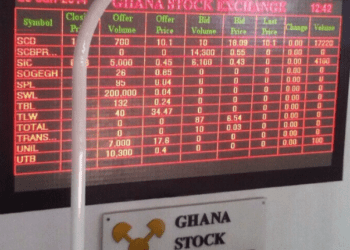The amount of outstanding credit extended by commercial banks to the Agriculture, Forestry and Fishing sector declined by 35.41 per cent year-on-year in April 2021.
At face value, outstanding credit to the sector reached GHS1.54 billion in April 2021 compared with GHS2.38 billion in April 2020. This reflects a widening gap in the advancement of credit to the sector. On the bright side, however, this amount also represents a slight improvement in previous months’ value only by a negligible 0.5 per cent.
Expectations were that while the Covid-19 pandemic may have attributed to the persistent decline of credit to the sector since April 2020 except in November and December 2020, the waning impact of the pandemic would revive some level of interest in the sector due to food security concerns. Albeit for the first four months of the year, credit to the sector has been on the decline on average.
Considering the sectorial distribution of outstanding credit by banks, the Agriculture, Forestry and Fishing sector numbered among the sectors to have received the least of credit in the period.
However, this is not surprising as banks have historically extended low amounts of credit to the sector. This trend has been sustained due to a number of reasons including high risk perception of the sector, existential risks such as diseases, pests and diseases and changes in climatic factors.
Fundamental to this trend is the fact that banks do not find the sector strategically important, as it is highly informal. As a result, unavailability of documentation and registered collateral for loans is commonplace, among others.
Following this, the Agriculture, Forestry and Fishing sector for decades has been underperforming due to the limited funds channeled into the sector, although there is optimism that the sector holds promise of driving economic growth.
Sectorial Distribution of credit by Banks
Sectors such as the Manufacturing (+8.8%, year-on-year), Transport, Storage and Communication (+10.19%, year-on-year), Construction (+13.91%, year-on-year), Commerce and Finance (11.06, year-on-year), Electricity, Gas and Water (+2.1%, year-on-year), and Other Services (+31.76%, year-on-year) saw increase in credit. Given the Bank of Ghana’s Statistical Bulletin data, outstanding credit extended to the ‘Other Services’ sector was the largest.
According to the data, credit to the Other Services sector reached GHS14.05 billion in April 2021, increasing from GHS10.66 billion in April 2020. This reflects a 31.76 per cent increase on a year-on-year basis in April 2021.
Also, credit advanced for export trade as at April 2021 was GHS171.16 million while that of import trade was at GHS1.15 billion in April 2021. Credit advanced to the export trade sector increased from GHS166.43 million while that of import trade reduced from GHS1.19 billion.
Moreover, banks’ credit for cocoa marketing specifically also shot up in the reviewed period to GHS168.59 million from GHS63.19 million.
Considering the above, and with particular reference to the Agriculture, Forestry and Fisheries sector, this trend of low financing provides ample reason for a more targeted means of financing for the sector.
For this purpose, the government has planned the establishment of a National Development Bank which is due to begin operations by the end of this month of July 2021. The bank is one of the key pillars within the broader policy umbrella- the Ghana CARES/Obaatanpa Programme.
The expectation is that, the bank will help raise long-term funds for private sector investments and specifically, provide credit for investments in the Agriculture and Manufacturing sectors and others.























